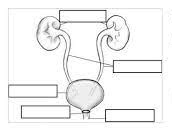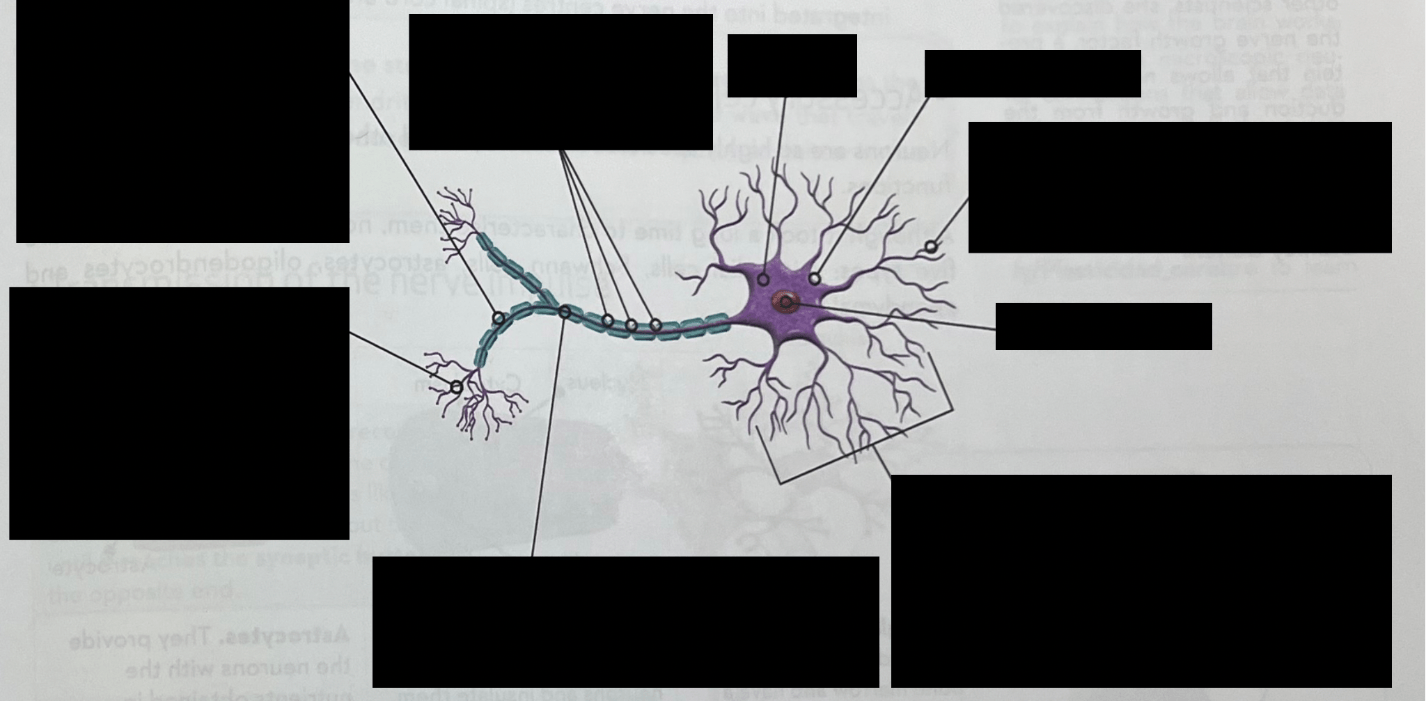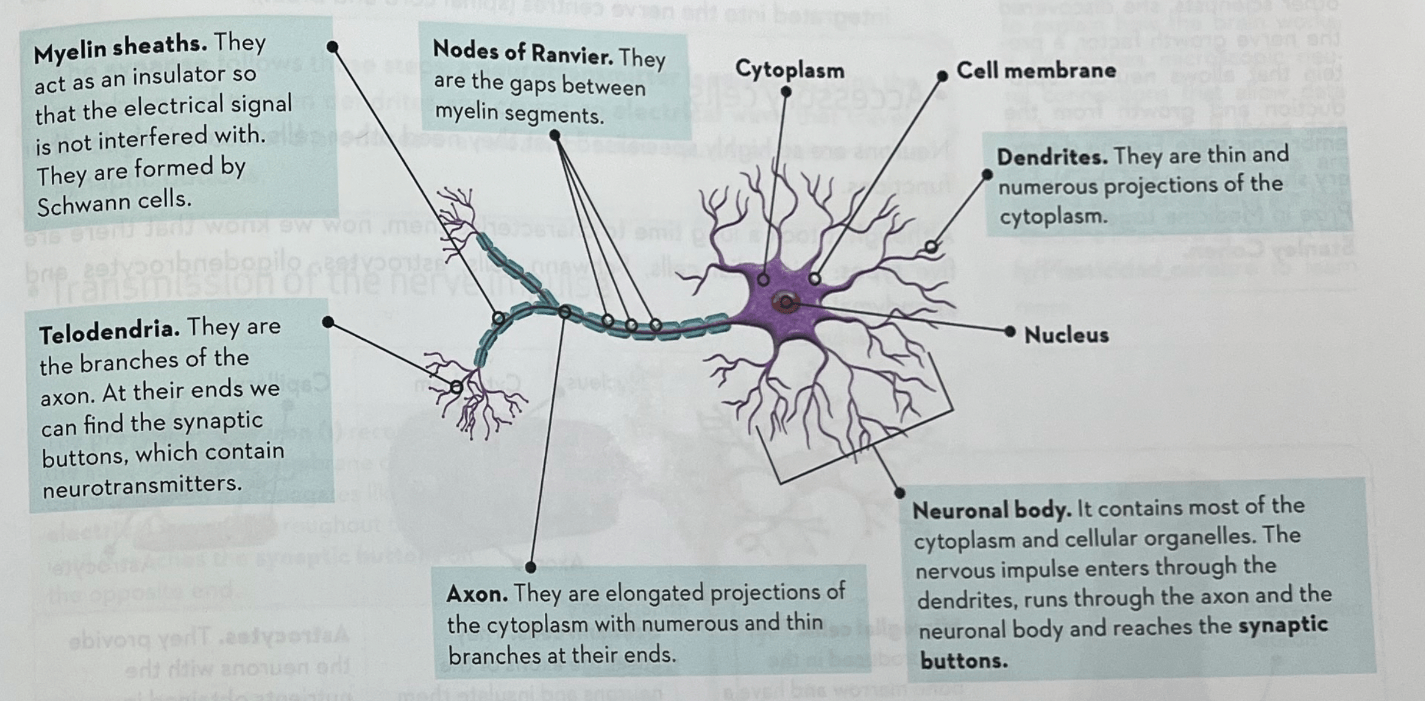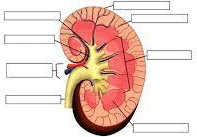Define ”excretion”
The process by which the waste substances from cellular metabolism are eliminated from the body.
Label the parts of the urinary system:
Kidneys, ureters, bladder, urethra, urine
Free 100 Points!
WOOHOO!
What is the specific function of a neuron?
Transmitting the nervous impulse
List the organs and systems involved in excretion
Sweat glands, the respiratory system, the urinary system, and the liver
What are the kidneys responsible for?
The kidneys are mainly responsible for filtering the blood, but they also control the volume of circulating blood and blood pressure.
What are healthy habits that can help you avoid disorders in the urinary system? You must list all to get points.
1. Staying hydrated
2. Reducing salt intake
3. Keeping a good personal hygiene
4. Going to the bathroom regularly
What occurs and is involved in each step:
1. Stimuli
2. Internal or external receptor
3. Integrating-processing system
4. Effector organs
5. Response
1. Stimuli - changes in body internal or external conditions
2. Internal or external receptor - sense organs/specialised cells
3. Integrating-processing system - nervous system/endocrine system; they generate a new signal that acts on…
4. Effector organs - muscles/glands; they respond to the signal executed by the nervous and the endocrine systems
5. Response - muscle contraction or relaxation; secretion of substances
What is the purpose of bile?
Bile is released into the intestine, which ends up eliminating waste substances, such as bilirubin, with faeces.
What are the nephrons in charge of?
Nephrons are in charge of…
1. Filtering and purifying the blood
2. Elaborating urine
3. Reabsorbing nutrients that can be used after filtering
What is renal colic?
Some salts (uric acid, calcium phosphate, etc.) that are found in the urine precipitate and build up forming kidney stones. These stones can reach a considerable size and cause intense pain when descending through the ureters.
Label the parts of the neuron:


Provide the following information about the urinary system:
1. It’s responsibility
2. What it eliminates
3. What it produces
It is responsible for eliminating certain waste substances generated as a result of cellulnar metabolism, such as urea and the uric acid. It produces urine.
What are the phases of urine formation? Describe each phase.
1. Filtration - The blood plasma that circulates through the glomerulus is filtered in the Bowman’s capsule. The glomerular filtrate is formed.
2. Reabsorption - It is the return of the usable substances (glucose, amino acids, and certain ions) into the bloodstream. It occurs in The renal tubule.
3. Secretion - Capillaries secrete waste substances into the distal convoluted tubule that have not been filtered in the first phase or that have been reabsorbed by mistake in the second phase. Urine is formed.
What is kidney failure?
Disorder caused by a poor performance of the kidneys. When urine production decreases, waste accumulates in the blood and can cause very serious disorders. It is essential to apply haemodialysis or perform a kidney transplant. It can be temporary (acute) or permanent (chronic).
What are the steps that the synapse follows:
A neurotransmitter is released, joins the membrane of neuron dendrites and causes an electrical wave that travels through the cell and produces the release of a new neurotransmitter in the synaptic buttons.
Provide the following information about the liver:
1. What it produces
2. What it does
3. Its responsibility
The liver produces bile, but it also transports waste substances, such as bilirubin, which comes from the degradation of haemoglobin. Bile is released into the intestine, which ends up eliminating these substances with farces. The liver is the main organ responsible for eliminating the remains of medicines and other toxic substances, such as alchol.
Label the parts of the kidney:

Renal capsule, renal cortex, renal artery, renal vein, renal medulla, renal pelvis, renal pyramids, and nephron
What is cystitis?
It is an inflammation of the urinary bladder, mainly as a result of an infection. It usually causes a constant feeling of the need to urinate, burning sensation or urinary incontinence.
What are the steps in the transmission of the nerve impulse?
1. The presynaptic neuron receives the stimulus on the membrane of its dendrites
2. Then it propagates like an electrical wave through the cell, until it reaches the synaptic buttons on the opposite end
3. The synaptic buttons on the opposite end release stored neurotransmitters, into the so-called synaptic cleft, located between both neurons
4. Neurotransmitters bind to the postsynaptic neuron through specific receptors on its cell membrane